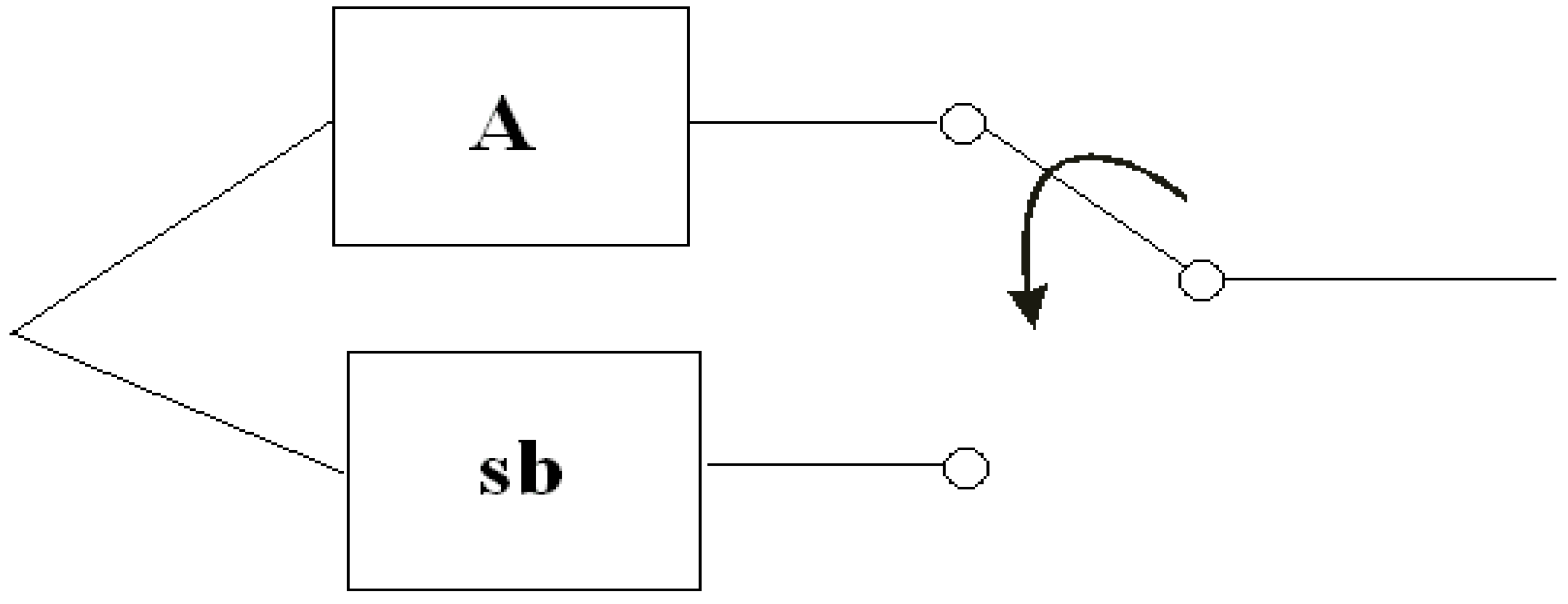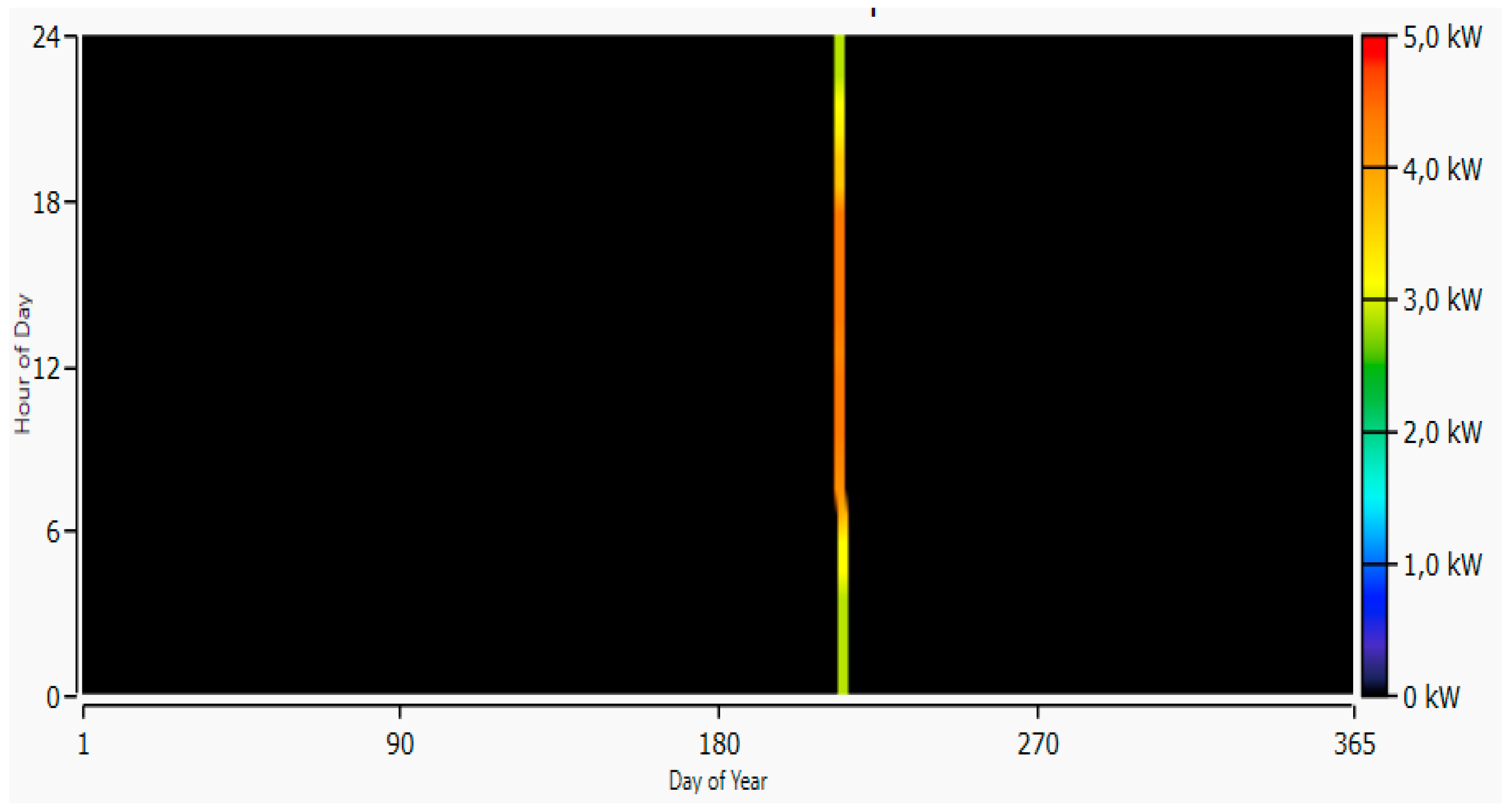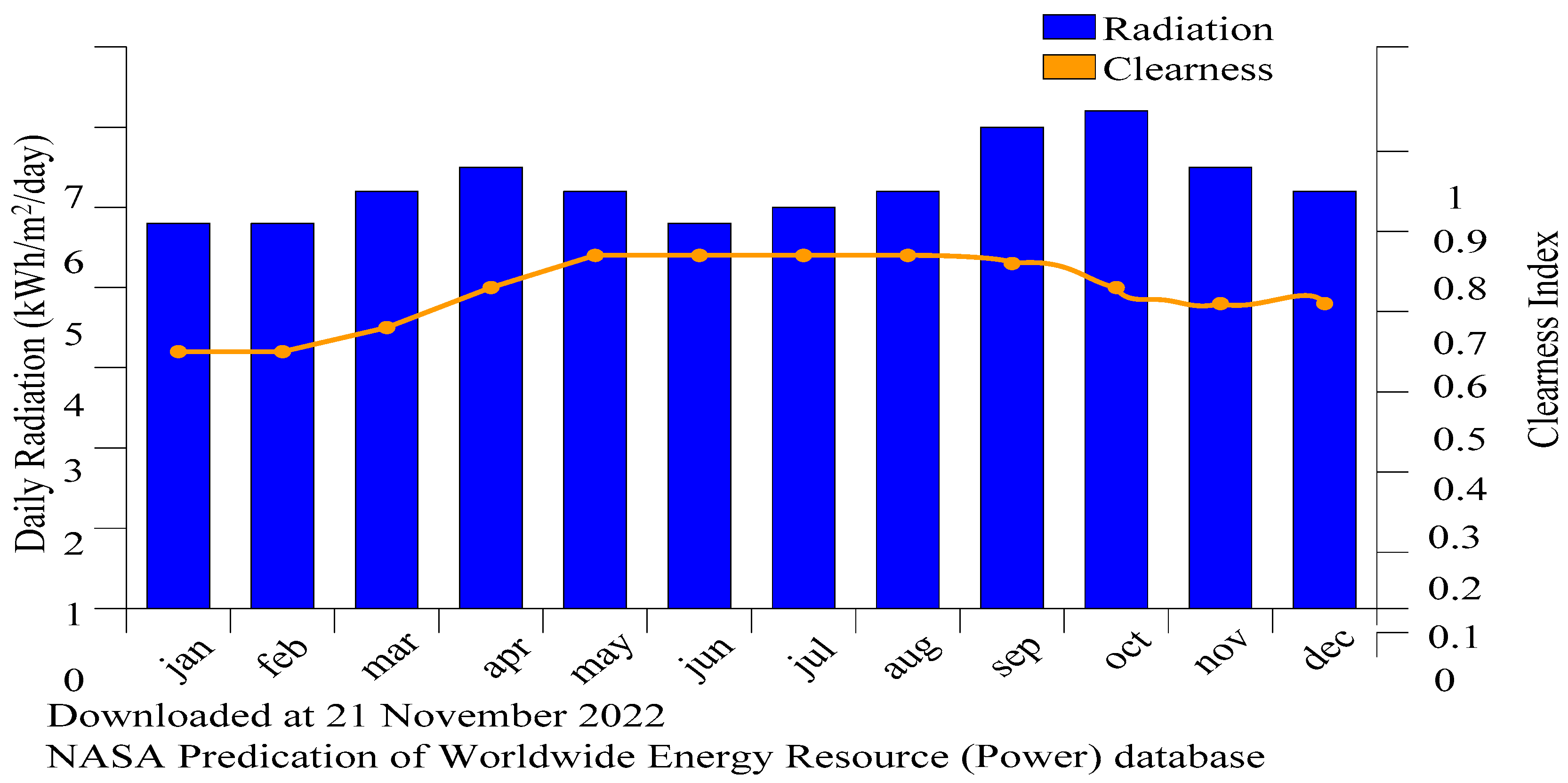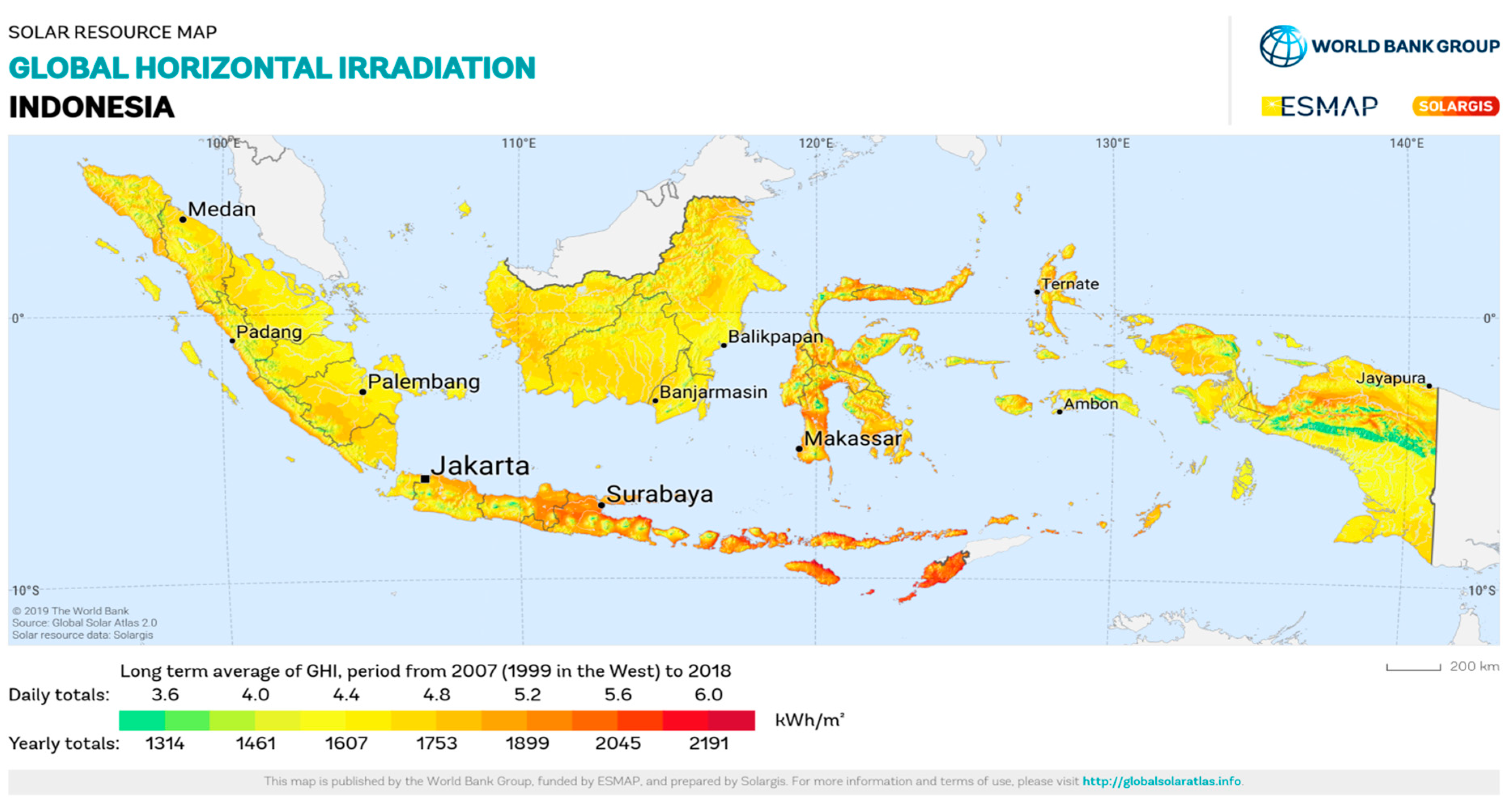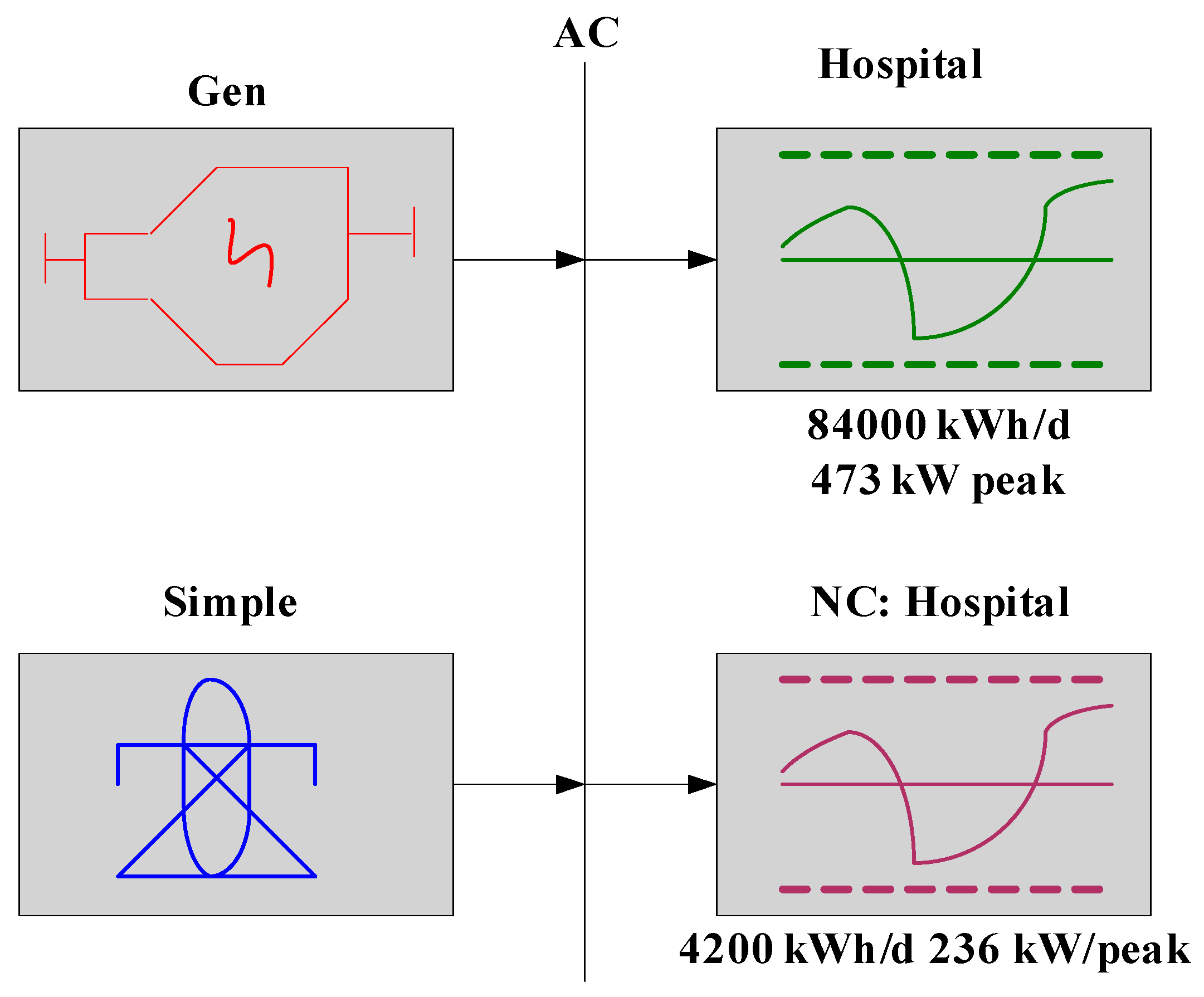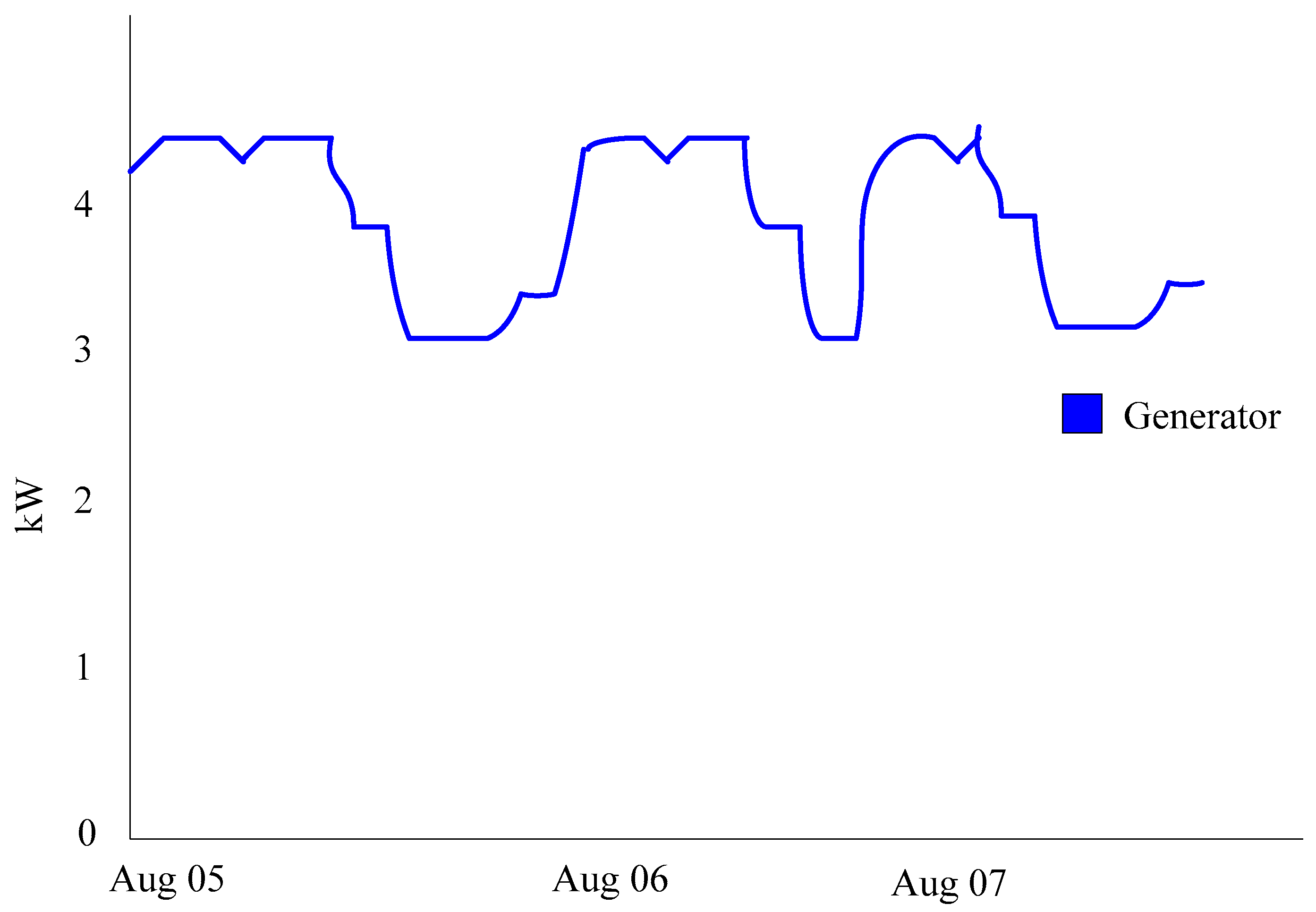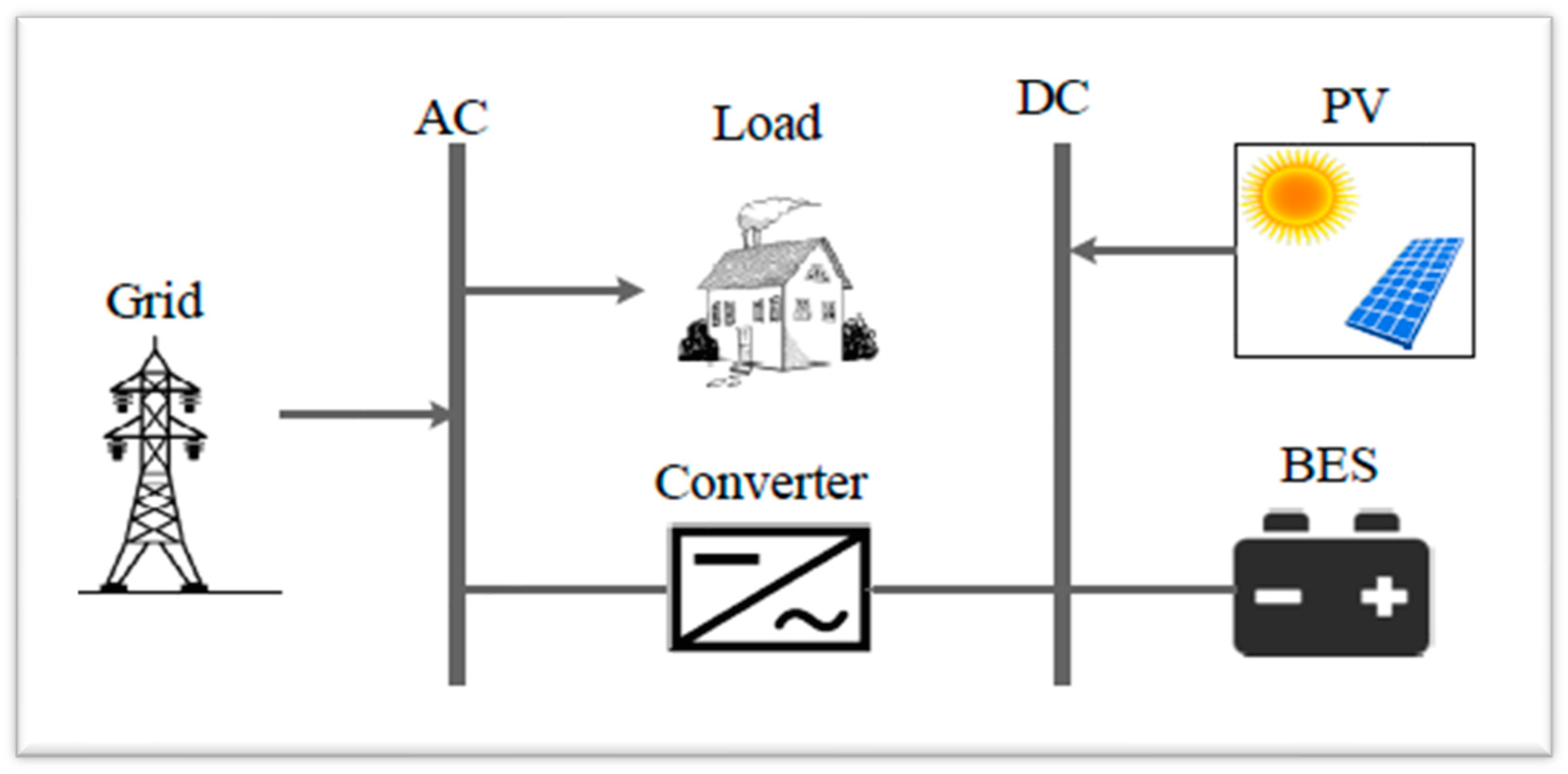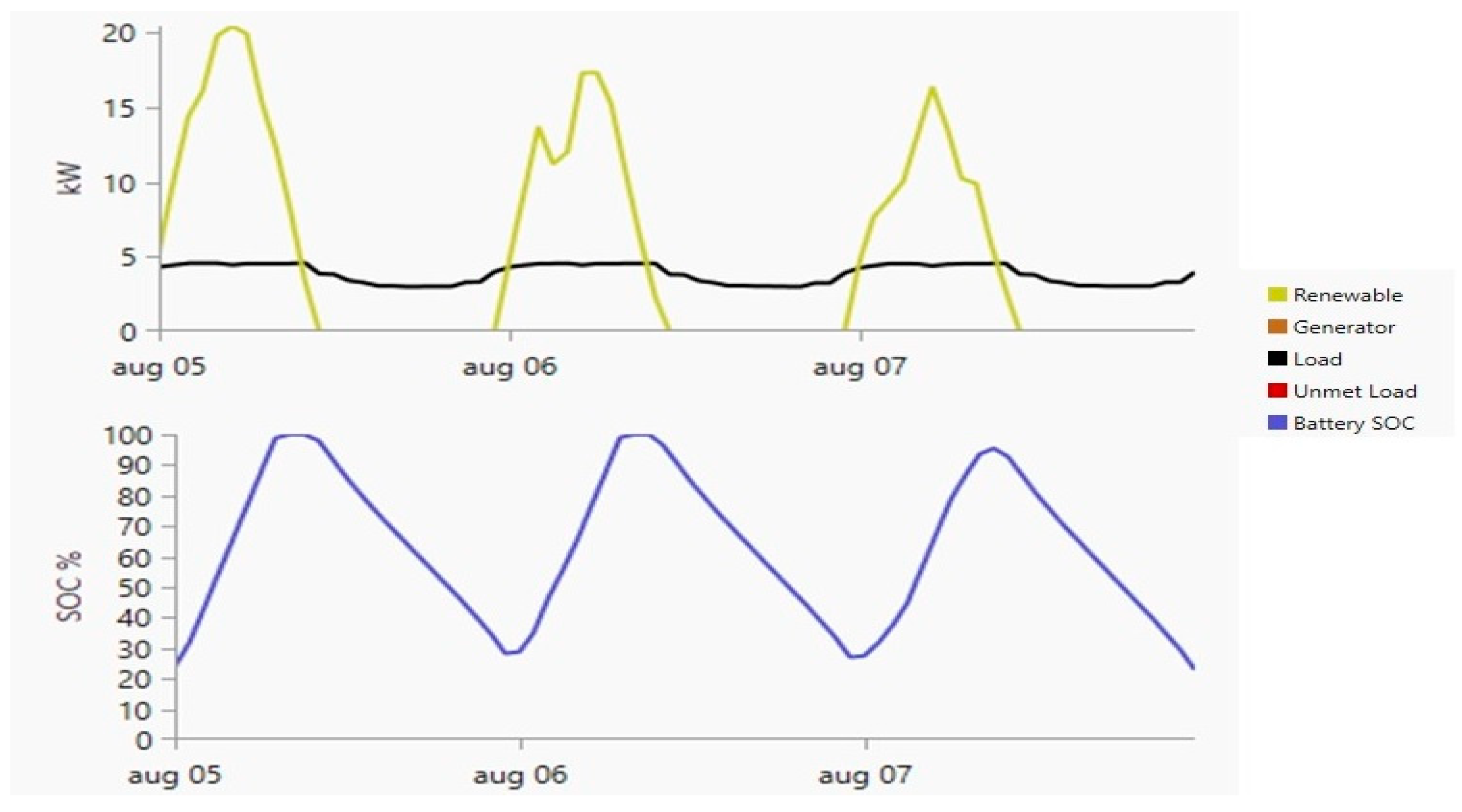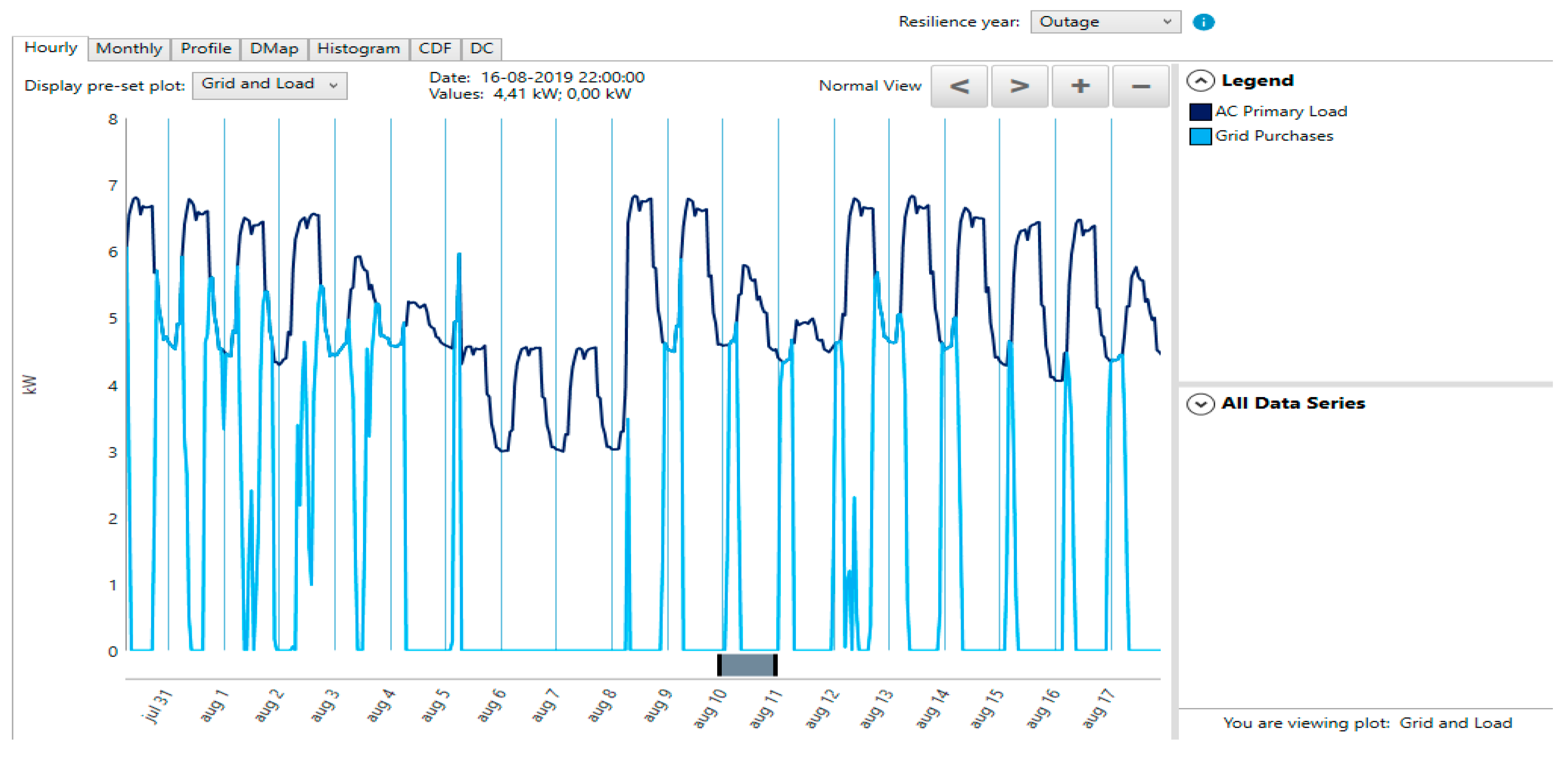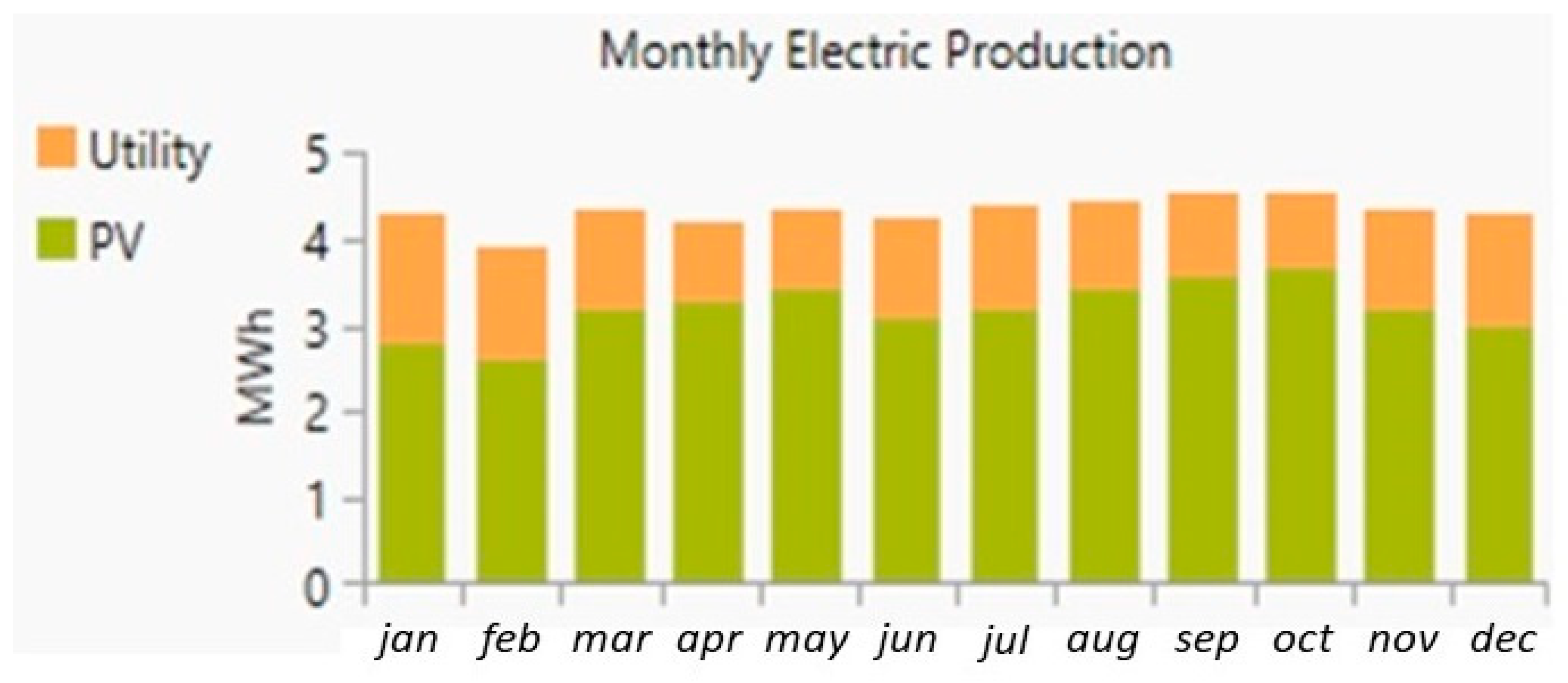2. Methodology
Figure 1 presents the basic concept of the proposed system. The general idea underlying standby (sb) redundancy is the same as that of a UPS system: all the components are still present even when they are not functioning. Only a system (A) power outage will enable the other standby components to function [
25,
26].
During a power outage in the system, these two components work as a standby system. For example, in system 1 (system A), when the power outage occurs, the critical load is connected to the DG via an auto-switching device. In system 2 (system sb), when the power outage occurs, the critical load is connected to PV + BES via an auto-switching device.
In this study, resiliency is measured by the term “survivability,” because it is the probability of the system having an electric supply during a power outage until the system is restored. Critical loads such as clinics, hospitals, and water filtration plants require 100% survivability during power outages [
27].
Figure 2 presents the grid outage data of the system 1 and system 2. The outage is assumed to last for 3 days during the year 2019, starting on 5 August at 7:00 AM and ending on 8 August at 7:00 AM, by using the HOMER Grid outage resilience function for both systems 1 and 2. In this simulation, two different systems, 1 and 2, consider supplying electric power to unmet loads during outages. HOMER Grid software is used for the simulations [
28]. The main purpose of this paper is to investigate the real-time analysis of the resiliency of the different systems during the outage of the power grid and to make an economic comparison between both systems.
The HOMER Grid provided the most favourable technology, size of the system, and optimal minimum net present cost (NPC).
The NPC cost is the whole system cost, which includes: (1) the capital costs; (2) the replacement costs; (3) the operation and maintenance cost (O&M); (4) the fuel cost; (5) the emission cost; and (6) the cost of purchasing power from the grid [
29,
30,
31,
32]. When determining the capital recovery factor (CRF) in Equation (2), the project life of 25 years is taken into account. A 10% annual increases in electricity costs as well as operating and maintenance expenses are taken into account in simulations. For HOMER grid simulations in 2019, there is an assumed 8% discount rate (DR) and a 2.8% inflation rate (IRR) [
33]. The generator was run for 72 h during a blackout at a cost of
$0.527 per hour. Equation (3) represented the total cost of energy (COE), generated form the system.
2.1. Input Data
Input data for the proposed models are given as follows:
For the case study, a small local hospital in Lombok (Mandalika) with a yearly load profile was chosen for both systems. The hospital’s emergency room, heating, cooling, and lighting systems were all considered while determining the critical load. The proposal of this study was to maximize resiliency during an outage for critical loads. The daily load profile for the hospital located in Mandalika is shown in
Figure 3.
- (B)
Solar radiation
The yearly solar radiation data is shown in
Figure 4. This is for the site located in Mandalika, Lombok Island. The data is available online at the National Aeronautics and Space Administration (NASA): Prediction of Worldwide Energy Resources (POWER). The pattern illustrated the peak value available from September to November as well as from March to May. The data shows that January to February and June to July has the lowest temperatures. The maximum annual solar radiation is 6.06 kWh/m
2/day during October. Yearly global horizontal irradiation (GHI) and photovoltaic power potential in Indonesia are shown in
Figure 5 and
Figure 6, respectively [
34].
Figure 5 presents the yearly global horizontal irradiation in Indonesia, which was utilized in this work. Moreover,
Figure 6 presents the yearly photovoltaic power potential in Indonesia used in this study.
- (C)
Electricity generation cost
Lombok Island’s electricity generation costs are
$0.13 per kWh [
30]. As a result, for the HOMER grid simulations in this paper, the authors take into account the 0.13 dollars per unit cost of energy consumption on Lombok Island. The electricity tariffs in Indonesia [
35] are shown in
Table 1.
2.2. System Modelling
- (A)
Power Grid
The power grid provides the system with unlimited power but experiences grid outages during the ND. The grid emission was also considered in this paper. During the grid operation, the HOMER grid showed carbon dioxide at 632 g/kWh, sulfur dioxide at 2.74 g/kWh, and nitrogen oxides at 1.34 g/kWh.
- (B)
PV System
In this study, 24 kW solar panels were used for the simulation. The technical characteristics of the solar system are shown in
Table 2. Installation, replacement, and maintenance (O&M) costs for a 1 kW solar PV system would be
$350 per kW,
$350 per kW, and
$10 per year, respectively.
Table 2 displays the technical specifications for this PV system. The output power of PV, which was introduced in the following equations [
36], was affected by environmental conditions such as temperature and irradiance.
The energy delivered by the PV system is [
37,
38,
39,
40,
41]
Equation (4) presented the Solar generation (Ppv(t)) in kW/hour. Tc(t) presented the temperature of cell (°C) and Epv(t) presented the produced energy from photovoltaic generation in kWh.
- (C)
Battery Energy Storage
Battery Energy Storage (BES) was used to store the extra energy available from the PV system during normal operating conditions and to provide energy to the load during abnormal conditions like power outages due to weather conditions. As this is a grid-connected MG, the battery would discharge to supply the load during normal operation, considering the economic factor, for instance, when the electricity price from the utility is high during the peak load. This paper used 60% of the battery’s state of charge (SOC) for power outage shaving, with the remaining 20% not being used as a minimum state. The battery’s SOC after a specific period of time (SOC (t + Dt)) during the charging and discharging procedures is defined in previous paragraphs, respectively. These equations demonstrate that the SOC equation has two essential parts: 1. SOC at the preceding period; and 2. The generation and consumption power at Dt.
These two Equations were only utilized when the SOC of BES was within the permitted ranges (9) [
37]:
SOC
max and SOC
min were the battery’s upper and lower storage bounds, respectively. These two boundaries should be the SOC of BES. When the battery’s SOC reached SOC
max and SOC
min, the used control system ceased charging and stopped discharging, respectively.
The lithium-ion battery is used as a storage device. The cost of each battery is
$124; replacement charges are also
$124; and operation and maintenance (O&M) charges are
$10 per year. The technical specification for this battery energy storage is shown in
Table 3.
- (D)
System Converter
A converter is required to interconnect the BES with the AC and DC buses. The efficiency of this converter was about 95% in both directions. The specification of the converter is illustrated in
Table 3. The estimated costs of the converter are as follows: capital cost =
$137/kW, replacement cost =
$137/kW, and
$10/year for operation and maintenance (O&M) [
32,
42,
43]. The technical specification for this system converter is shown in
Table 4.
- (E)
Diesel generator
In this simulation, the DG was operated with natural gas fuel. Generally, natural gas generators are better than diesel generators and good for plug-and-play operations at local clinics [
32]. Normally, the DG operates for off-grid generation and operation when there are outages in the power grid. The specification of the diesel generator (DG) is shown in
Table 5. The initial cost of DG is
$1500 per kW, the replacement cost is
$750 per kW, and operation and maintenance costs are
$0.05 per hour. Furthermore, the emissions produced by the DG were included, which considered: 6.42 g/m
3 of fuel in carbon monoxide; 0.0 g/m
3 of fuel in unburned hydrocarbons; 0.181 g/m
3 of fuel sulfur converted to particulate matter; and 13.47 g/m
3 of fuel nitrogen oxides [
31]. The technical specification for this system converter is shown in
Table 5.
3. Results and Analysis
The load considered in this study is a local hospital located in Mandalika, Lombok Island, with 84 kWh/day and a 4.73 kW peak in a day, and the critical load during an outage is 42 kWh/day with a 2.36 kW peak in a day.
- (A)
Grid-connected load without backup
As seen in
Figure 7, a grid-connected demand without a backup power supply is displayed, as is the load’s survival, in
Figure 8.
- (B)
System 1: Grid-connected load with DG Backup
In this system, the DG was connected to the load by using an AC bus, and standby served as a power source for emergencies like power outages due to natural disasters or weather conditions. The system-1 grid-connected load with a backup power system and HOMER grid configuration are shown in
Figure 9 and
Figure 10, respectively. As stated previously, the grid provides supply to the load without breaking during normal conditions and switches to the DG when the blackout happens. The generator supplied only critical loads when the outage occurred.
As shown in
Figure 11, during the outage, the generator would provide supply to the load, and there was no unmet load during an outage. As shown in
Figure 12, there is no power from the grid during an outage.
This paper considers a random blackout resulting from natural disasters with a mean frequency of one each year, and the duration of the blackout is assumed to be 72 h. Both systems 1 and 2 were simulated during the same blackout duration. A grid failure during the blackout would lead to a deficit of capacity as well as an ineffective supply of energy for the electrical load. As a result, the backup power system was created to make up for the electrical load that was not met. When there was a power outage, the DG System 1, as depicted in
Figure 13, delivered electricity. The electrical and economic parameters for System 1 are shown in
Table 6.
Figure 14 shows the monthly electric production by utility and generator. Except during blackouts, the utility-supplied electricity to the load.
System 1, which included a DG, produced emissions by burning fossil fuels. The simulation’s findings showed that System 1’s overall emissions amounted to 216.902 kg/year. The emission profile for system 1 is shown in
Table 7.
- (C)
System 2: Grid-connected load with RES Based ad hoc MG Backup
The proposed grid-connected ad hoc MG in this system consisted of a PV system, a BES system, and a load. The PV + BES system provides power in emergencies due to natural disasters or weather conditions. The system 2 grid-connected load with a backup power system and HOMER grid configuration are shown in
Figure 15 and
Figure 16, respectively. As previously mentioned, the electric grid and the MG supply the load during normal conditions, and the backup system PV + BES is supplied when the blackout happens.
There was no unmet load during an outage, as depicted in
Figure 17, because the PV and the BES supplied the load. There was no power coming from the grid during an outage, as depicted in
Figure 18.
As shown in
Figure 19, during the outage in System 2, the PV + BES-based ad hoc MG operated in the off-grid mode to supply the critical load. The maximum value of the SOC was 100%, and the minimum value of the SOC was 20%. The electrical and economic parameters for system 2 are shown in
Table 8. The BES results are shown in
Table 9 for System 2.
As per the simulation result, most of the power provided by the PV system to the load during the daytime is shown in
Figure 20.
The primary goal of each of the simulations was to increase the resilience by increasing the essential loads’ capacity to survive the system disruptions. Systems 1 and 2 were used to present two various optimal systems. As previously said, the DG is a typical system that offers electrical resilience. However, it is believed that the RES-based MGs are a highly effective apparatus for enhancing the resilience of the power supply. The persistence of the key loads improved the power system’s resilience, as shown in
Figure 11 and
Figure 17 for system 1 and system 2, respectively, from the results of the sensitivity analyses for systems 1 and 2. The standby systems that were operational during the outages were responsible for this increase in resilience.
The total net present cost of electricity over the year was
$136,805.50, and the yearly operating cost was
$3369.21 with a COE of
$0.2151 as shown in
Table 8. The optimization results of the battery energy storage system are presented in the
Table 9. According to the results in
Table 9, autonomy of the system was 9.12 h, energy in was13,452 kWh/year, energy out was 12,322 kWh/year, storage depletion was 0 kWh/year, system losses was 1062 kWh/year and annual throughput was 12,847 kWh/year.
According to the simulation results in
Table 10, system 2 showed a total emission of 63.292 kg/yr, which was very low when compared to system 1.
The resilience of both systems was the same as a result of the optimal design, but the economic outcome was different. NPC and the initial cost of System 2 were higher than System 1, but the COE and operating cost of System 2 were lower as compared to System 1. According to the simulation results, system 1 produced an emission of 216.902 kg/yr, and system 2 produced an emission of only 63.292 kg/yr. According to this research, RES-based MGs are more environmentally beneficial resources since they produce power without the use of fossil fuels.
5. Conclusions
This study enhanced the resiliency of the system and the supply of electricity to a critical load during a power outage in the main grid system. The main aim of this study was to design resilience-based systems for a local hospital to provide power during outages. Both systems worked as standby, being the DG in system 1 and the PV with BES in system 2. Despite the fact that both systems were equally resilient, system 2 produced fewer emissions than system 1. Given that climate change and emissions are important considerations when designing a system, the RES-based system produced fewer emissions. The NPC and the initial cost of system 2 were higher than system 1, but the COE and operating cost of system 2 were lower as compared to system 1. This study was performed for Lombok Island in Indonesia. The simulation’s findings showed that system 1 created an annual emission of 216.902 kg/yr while system 2 only produced an emission of 63.292 kg/yr. This study shows that since RES-based MGs do not burn fossil fuels to generate power, they are more environmentally friendly resources.
As the future enhancement of this work, it can be utilized for other locations as per different design parameters, e.g., economic and weather conditions. Furthermore, various optimization techniques under different operational, natural and economic constraints can be utilized for optimization of the proposed system.
